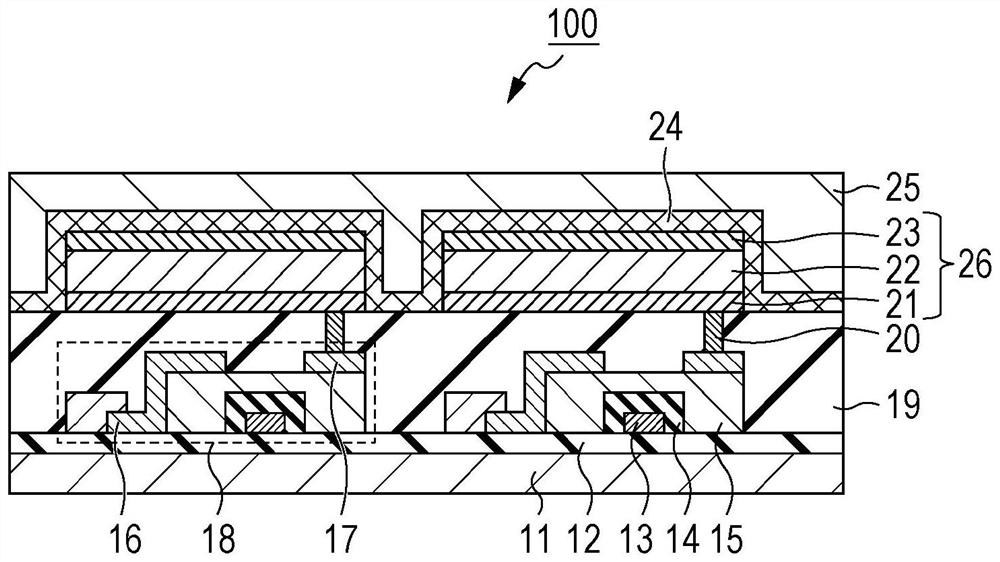Organic compound, organic light-emitting element, display device, photoelectric conversion device, electronic device, illumination device, and exposure light source
A technology of organic light-emitting elements and organic compounds, which is applied in the field of exposure light sources and can solve problems such as luminous efficiency problems
- Summary
- Abstract
- Description
- Claims
- Application Information
AI Technical Summary
Problems solved by technology
Method used
Image
Examples
Embodiment 1
[0243] Example 1 (Synthesis of Exemplary Compound A1)
[0244] Exemplary compound A1 was synthesized according to the following scheme. The following scheme is the above reaction scheme in which the compound E1 in which X is an oxygen atom is used as the compound (a).
[0245]
[0246] (1) Synthesis of compound E3
[0247] Place the following reagents and solvents in a 300ml recovery bottle.
[0248] Compound E1: 5.0 g (27.3 mmol)
[0249] Compound E2: 7.7 g (27.3 mmol)
[0250] Pd 2 (dba) 3 : 0.7g (0.8mmol)
[0251] P(t-Bu) 3 : 0.6g (2.7mmol)
[0252] NaO-t-Bu: 5.2 g (54.6 mmol)
[0253] Toluene: 100ml
[0254] Next, the reaction solution was stirred with heating at 100° C. for 12 hours under nitrogen flow. After heating and stirring, the resultant was extracted with toluene, and the organic layer was concentrated and dried to obtain a solid. The obtained solid was purified by silica gel column chromatography (mixture of toluene and heptane) to obtain 6.5 g of ...
Embodiment 23
[0278] In this example, an organic EL element having a bottom emission structure in which an anode, a hole injection layer, a hole transport layer, an electron blocking layer, a light emitting layer, a hole blocking layer, an electron transport layer, an electron injection layer, and a cathode are produced was produced are sequentially formed on the substrate.
[0279] First, an ITO film is formed on a glass substrate and desirably patterned, thereby forming an ITO electrode (anode). At this time, an ITO electrode was formed so as to have a thickness of 100 nm. The substrate on which the ITO electrode was formed in this manner was used as an ITO substrate in the following steps. Next, organic compound layers and electrode layers shown in Table 5 below were successively formed on the ITO substrate by performing vacuum deposition by means of resistance heating in a vacuum chamber. At this time, the electrode area of the electrode (metal electrode layer, cathode) facing the I...
Embodiment 24~27
[0283] Examples 24 to 27, Reference Example 28, and Comparative Examples 1 and 2
[0284] An organic light-emitting element was produced in the same manner as in Example 23, except that the materials for forming each layer were appropriately changed to the compounds shown in Table 6. For layers not listed in Table 6, the same composition as in Example 23 was used. The properties of the resulting element were measured and evaluated in the same manner as in Example 23. The measurement results are shown in Table 6 together with the measurement results of Example 23.
[0285] Table 6
[0286]
[0287] As shown in Table 6, in Examples 23 to 27, organic light-emitting elements each having a high maximum external quantum efficiency (E.Q.E.) and a long 5% degradation lifetime (LT95) were obtained. That is, in Examples 23 to 27, organic light-emitting elements having high luminous efficiency and high driving durability were obtained. In other words, the example compounds shown i...
PUM
| Property | Measurement | Unit |
|---|---|---|
| thickness | aaaaa | aaaaa |
Abstract
Description
Claims
Application Information
 Login to View More
Login to View More - R&D
- Intellectual Property
- Life Sciences
- Materials
- Tech Scout
- Unparalleled Data Quality
- Higher Quality Content
- 60% Fewer Hallucinations
Browse by: Latest US Patents, China's latest patents, Technical Efficacy Thesaurus, Application Domain, Technology Topic, Popular Technical Reports.
© 2025 PatSnap. All rights reserved.Legal|Privacy policy|Modern Slavery Act Transparency Statement|Sitemap|About US| Contact US: help@patsnap.com



